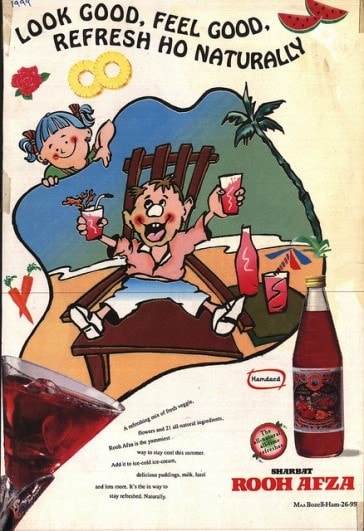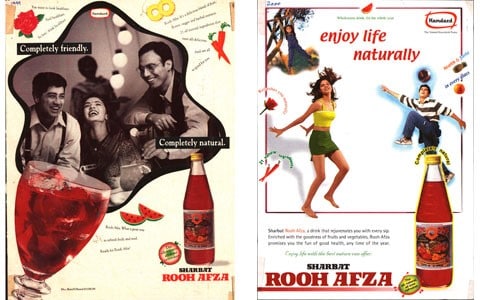It’s 2023 and Rooh Afza, also known as the “refresher of the soul,” is still going strong. This drink has seen India’s partition, the birth of Pakistan and Bangladesh, and continues to provide relief and calm during hot summers or humid climates. Scrolling through Twitter, I came across several tweets expressing fondness for the 116-year-old brand, which has been tantalizing taste buds since 1907.
“It is the quality of the product,” says Hamid Ahmed, chief executive officer, Hamdard Laboratories India – food division. “Once you take a sip, you become aware of its quality,” he mentions.
Popularity during Ramadan
Rooh Afza has a deep connection with the holy month of Ramadan and holds significant cultural relevance and nostalgia for generations. During Ramadan, the brand experiences high sales and is often the preferred drink to break the fast with.
Over the past decade, Ramadan has been during the summer, which has boosted Rooh Afza sales. However, in the upcoming years, Ramadan will occur during winter months, posing a challenge for the brand as its cooling properties are typically associated with summer.
Nostalgia and how! Memories of milkshakes on hot summer days. And then those days we used to reuse empty bottles as water bottles and for a week or two, we’d taste rooh afza in our water. pic.twitter.com/nvgH3y7hpo
— Gurprriet Siingh (@JoyAndLife) April 10, 2023
Traditionally, the Rooh Afza season ends with the onset of the monsoon season. To remain relevant in the winter months, the brand needs to create a new usage occasion that encourages consumption. Sridhar Samu, founder of Samu Consultants, suggests that addressing this challenge could bridge the gap and help Rooh Afza maintain its popularity throughout the year.
Rooh Afza: Its evolution, its advertising and marketing
Ahmed’s forefathers used to prepare the ‘sherbet’ in their kitchens, and people from the locality of Old Delhi would come to collect it. The fragrance of the sherbet would waft and spread throughout the locality.
At the time of partition, Ahmed’s grandfather Hakim Abdul Hameed chose to stay in India, and his younger brother Hakim Mohammad Said decided to cement his roots in Pakistan. That is where he set up Hamdard Laboratories (Waqf) Pakistan.
Rooh Afza is manufactured in three countries: India, Pakistan and Bangladesh. Import or export of Rooh Afza between these three countries goes without a possibility. Since these are three different countries, the manufacturing is held by three different trusts which are Hamdard Laboratories India, Hamdard Laboratories (Waqf) Pakistan and Hamdard Laboratories (Waqf) Bangladesh.
In the 1940s and 1950s, when direct lines of communication were very difficult, Hamdard used to advertise Rooh Afza in remote locations by dropping pamphlets from helicopters. At present, television, print, radio and outdoor are their main mediums. Since digital media is fast becoming one of the most used mediums, their spends have now been diverted to that space.

In the 1960s and 1970s, Hamdard projected Rooh Afza as the ‘Summer drink of the East’. However, in the 1980s and 1990s, the parent company made a conscious decision and stopped calling Rooh Afza as the ‘summer drink of the East’. This was despite the brand’s salience being strong during that season.
The sherbet or the syrup can be mixed not just with chilled water, but can be mixed with milk, and can be used to flavour a cold dessert named falooda. Rooh Afza, which is available at Rs 170, for the financial year FY 2022 – FY 2023, its sales numbers stood at 4,00,00,000, which is an all time high. The brand sells in around 50 countries, and India stands as its highest selling country. Pakistan and the Middle East follow after India.
Team jaam e Shireen
or Team Roohafza? pic.twitter.com/747gftXYXU— Ahmed.. 🇵🇰🇵🇸 (@nwgenerationX) April 9, 2023
New Delhi and Punjab have been the traditional markets for Rooh Afza, and Maharashtra is the new entrant where an uptake in its sales numbers has been witnessed. The brand, which enjoys a 50 percent – 60 percent market share in the sherbet category, its main competitors are the rose syrups of different brands.
Since Rooh Afza is present on a pan India level, Samu thinks they need to ask themselves certain questions if they want to taste further success. ‘How can I do this?’ ‘Should I sell with the same brand name?’ ‘Should I come up with a different brand name to improve brand resonance?’

In 2020, when Covid-19 gripped the entire world in its clutches, the product suffered a 20 percent reduction in its sales and revenues. Situation was difficult in 2021 too. However, the brand went on to witness a substantial increase of 80 percent later on.
Currently, Hamdard Laboratories India has got two manufacturing facilities running. One is present in Manesar, Gurgaon, and the other is located in Aurangabad,Maharashtra, which came into operation last year.
Rooh Afza is present on e-commerce platforms like Amazon, Flipkart and JioMart, and can be found in supermarkets and retail outlets too. Ahmed adds, “We have got our own e-commerce strategy and that will get launched anytime soon this month.”
Expansion of its product offerings
Rooh Afza has always aimed to be a staple in households, especially among children. To appeal to Gen Z, the brand introduced Rooh Afza milkshake and lassi in 2017 and 2018, and Rooh Afza Fusion in 2016. However, the latter has not been successful, possibly due to flavor preferences differing across regions. The brand is now trying to introduce new flavors such as Rooh Afza mixed with coconut water.
According to Hemant Mishrra, founder and CEO of Neeti Brand Accelerator, the brand needs to align with the expectations of the younger generation and fit into their daily routine. Mishrra believes that brands need to have a good story to create emotional connectivity with their audience.
Hamdard Laboratories India plans to revamp Rooh Afza Fusion, which is currently available in five flavors, by next year. Rooh Afza milkshake and lassi are available during the monsoon season and also in October and November.
In 2020, Rooh Afza began to be sold in Rs 10 sachets, which has found great uptake in Uttar Pradesh. The parent company also launched a ready-to-drink carbonated version called Red Rush, which is aimed at the youth market. The brand is awaiting feedback to make the product more relevant to this audience.
Rebranding: An ideal decision?
In 2023, a significant number of brands underwent changes in their visual identity, such as logo or packaging. Some of the notable brands that made changes to their look and feel were Nokia, Pepsi and Fanta. While rebranding or reinventing a heritage brand can have its advantages and disadvantages, some brands like Rooh Afza have made minor changes to comply with regulatory requirements.
According to Ahmed, a representative of Rooh Afza, the brand has made minor changes to the label, such as toning down the color blue at the back, and updating the label to comply with the new regulatory requirements by FSSAI (Food Safety and Standards Authority of India). The sherbet contains extracts of vegetables and fruits, including pineapple juice and orange juice, but they do not amount to 50 percent, which is required to mention the presence of fruits and vegetables on the label.
Brand expert Samu suggests that changing the look and feel can have positive and negative effects. The positive side of rebranding is that it can make the brand look more contemporary and appeal to a younger crowd. However, it can also lead to losing some key brand associations, which are critical for the brand’s success. Therefore, it is essential to identify which brand associations are critical and make sure they are not lost.
Mishrra adds that reinventing a brand’s story, product offering, and packaging is necessary, especially when new brands are coming up with similar offerings, which can eat into the brand’s market share. Therefore, it is essential to keep reinventing the brand to stay relevant in the market.
Dealing with counterfeit products
In 2022, there were reports of Rooh Afza, a Pakistani-manufactured product, being sold on Amazon India without complete details of the manufacturer being present on the label. The Delhi High Court eventually ordered Amazon India to take down the products from its site.
Regarding counterfeit products, Ahmed explains that it is a recurring issue for Rooh Afza every season. The problem is likely to resurface again this season. Rooh Afza has a legal team that tracks such issues and takes action against them. For instance, when someone from Jammu was manufacturing Rooh Afza, Rooh Afza’s team went there and got the local administration’s help to confiscate the products and shut them down. The regions of Uttar Pradesh and Agra are also known for the arrival of counterfeit Rooh Afza products seasonally.
How strong is the effect of nostalgia and cultural relevance?
According to Samu, Rooh Afza’s strong cultural relevance and nostalgic value associated with Ramadan are not enough for the brand to survive. Samu cites Paper Boat, a beverage company that came up with a variety of offerings like Aamras, Thandai, and others, as an example. Although people gave Paper Boat’s products a try due to nostalgia, they eventually moved on.
Rooh afza because it makes my rooh happy
— 🌻 (@The__Sunflower_) April 7, 2023
Samu believes that Rooh Afza needs to work on establishing a clear brand differentiator, as it is currently positioned on the basis of versatility and specific usage during occasions.
Regarding tie-ups with other companies or acquisitions of brands or products, Ahmed did not disclose much detail but mentioned that Hamdard Laboratories India is in touch with certain companies and has signed non-disclosure agreements (NDAs).
Ahmed also highlights that many consumers are not aware of the ingredients used in Rooh Afza, which can lead to negligence in preparing the sherbet. He requests that people read the label of Rooh Afza, as the ingredients used, including mint extract, are very cooling for the body.
